

The Tube: IDEO Builds a Collaboration System That Inspires through Passion. Design Principles: IDEO's Knowledge Sharing Team synthesized their findings into five design principles that guided the creation of the Tube, and scale and adapt to inform similar efforts within other organizations. 1) Build Pointers to People: rather than trying to take all of the knowledge out of people’s heads and store it in a giant database, focus primarily on helping people to identify who they are -- their passion, experience, and expertise -- and connect people based on that information. 2) Build Rewarding Systems: a system that requires altruism is unlikely to be successful.
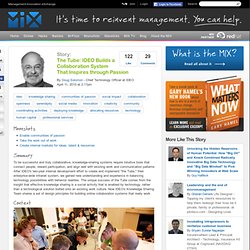
Similarly, systems that require users to participate (e.g. compliance-based design) rarely get anything more than participation at the lowest required level. Effective knowledge sharing systems must simultaneously meet the needs of the organization while motivating individual participation. Hay Group report on Engagement. Randstad onderzoek Empl Engagem. Randstad survey identifies top factors that keep workers engaged Flexibility, corporate culture and rewarding high performance are important to cultivate happy and productive employees, according to the Q2 2013 Engagement Study commissioned by Randstad, the second largest HR services and staffing company in the world.
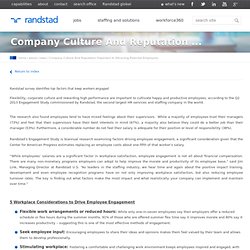
The research also found employees tend to have mixed feelings about their supervisors. While a majority of employees trust their managers (73%) and feel that their supervisors have their best interests in mind (67%), a majority also believe they could do a better job than their manager (53%). Furthermore, a considerable number do not feel their salary is adequate for their position or level of responsibility (38%). Randstad’s Engagement Study is biannual research examining factors driving employee engagement, a significant consideration given that the Center for American Progress estimates replacing an employee costs about one-fifth of that worker’s salary.
Employee Engagement. The Pursuit of Happiness: Can We Have an Economy of Well-Being? - Up Front Blog. At this year’s American Economic Association meetings in Denver, there were the usual panels on topics like the financial crisis and the real estate market.
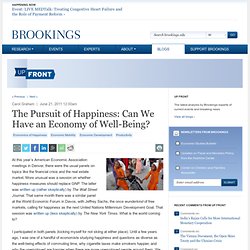
More unusual was a session on whether happiness measures should replace GNP. The latter was written up (rather skeptically) by The Wall Street Journal. That same month there was a similar panel at the World Economic Forum in Davos, with Jeffrey Sachs, the once wunderkind of free markets, calling for happiness as the next United Nations Millennium Development Goal. That session was written up (less skeptically) by The New York Times. What is the world coming to? I participated in both panels (kicking myself for not skiing at either place).
There is also talk of happiness as a policy objective. This is exciting for scholars. In my new book, The Pursuit of Happiness, I posit that the definition of happiness that individuals select is partly determined by their capacity to pursue fulfilling lives. Positive Psychology. Introducing the Collaboration Curve - John Hagel III, John Seely Brown, and. By John Hagel III, John Seely Brown and Lang Davison | 2:38 PM April 8, 2009 There’s a classic story in economics primers illustrating the power of network effects.

It tells how the first fax machine gave little value to its owner–after all, there was no one else with whom to send and receive faxes. As time went by, however, the value of that first machine increased as other people bought fax machines, and soon its owner could send faxes to the far corners of the earth, and receive them in return. Is big the enemy of good? How to grow without crushing agility and creativi. Remember working for that start-up?
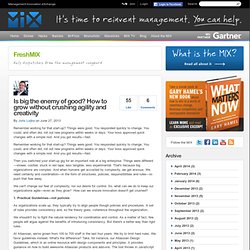
Things were good. You responded quickly to change. You could, and often did, roll out new programs within weeks or days. Your boss approved quick changes with a simple nod. And you got results—fast. Then you switched your start-up gig for an important role at a big enterprise. We can't change our fear of complexity, nor our desire for control. 1.
As organizations scale up, they typically try to align people though policies and procedures. We shouldn't try to fight the natural tendency for coordination and control. At Atlassian, we've grown from 100 to 700 staff in the last four years. The best bit is that the tool doesn't interfere with the developers' design process, it just helps them work faster (they can quickly cut and paste code) so they can experiment freely while still retaining a base level of consistency. Employee Engagement Study. In this employee engagement study, Elizabeth Craig of the Accenture Institute for High Performance and Lauren DeSimone of the International Consortium for Executive Development Research, explore this topic in depth.
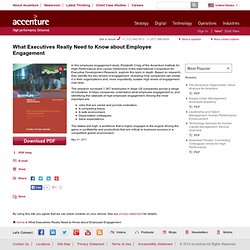
Based on research, they identify the key drivers of engagement, revealing how companies can create it in their organizations and, more importantly, sustain high levels of engagement over time. The research surveyed 1,367 employees in large US companies across a range of industries. It helps companies understand what employee engagement is, and identifying the catalysts of high employee engagement. Among the most important are: Jobs that are varied and provide motivation. The stakes are high: a workforce that is highly engaged is the engine driving the gains in profitability and productivity that are critical to business success in a competitive global environment.